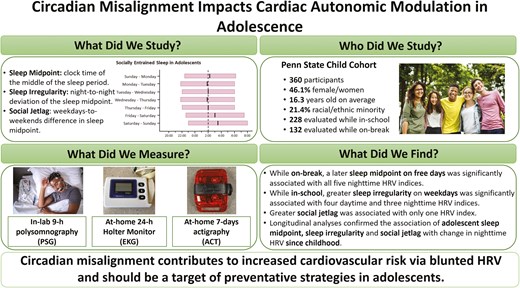2025-02-17 ペンシルベニア州立大学 (Penn State)
<関連情報>
- https://www.psu.edu/news/research/story/timing-and-regularity-sleep-may-be-key-adolescent-heart-health
- https://academic.oup.com/sleep/advance-article-abstract/doi/10.1093/sleep/zsaf015/7960092
概日リズムのずれは青年期の心臓自律神経調節に影響する Circadian Misalignment Impacts Cardiac Autonomic Modulation in Adolescence
Natasha Morales-Ghinaglia, Fan He, Susan L Calhoun, Alexandros N Vgontzas, Jiangang Liao, Duanping Liao, Edward O Bixler, Julio Fernandez-Mendoza
SLEEP Published:18 January 2025
DOI:https://doi.org/10.1093/sleep/zsaf015

Graphical Abstract
Abstract
Study Objectives
Although heart rate variability (HRV), a marker of cardiac autonomic modulation (CAM), is known to predict cardiovascular morbidity, the circadian timing of sleep (CTS) is also involved in autonomic modulation. We examined whether circadian misalignment is associated with blunted HRV in adolescents as a function of entrainment to school or on-breaks.
Methods
We evaluated 360 subjects from the Penn State Child Cohort (median 16y) who had at least 3-night at-home actigraphy (ACT), in-lab 9-h polysomnography (PSG) and 24-h Holter-monitoring heart rate variability (HRV) data. ACT-measured metrics of circadian misalignment included sleep midpoint (SM), sleep irregularity (SI), and social jetlag (SJL). Five 24-h, daytime and nighttime frequency- and time-domain HRV indices were the primary outcomes. Linear regression models adjusted for sex, race/ethnicity, age, body mass index, apnea/hypopnea index, sleep duration and its variability. These associations were also examined as a function of being in-school or on-break.
Results
While on-break, a later SM on weekends was significantly associated with all five nighttime HRV indices. While in-school, greater SI on weekdays was significantly associated with three daytime and three nighttime HRV indices. Greater SJL was not associated with any HRV index. Longitudinal analyses confirmed the association of adolescent SM, SI and SJL with change in nighttime HRV since childhood.
Conclusions
An irregular sleep phase during days of entrainment to social demands and a delayed sleep phase during ad-libitum days are associated with blunted HRV in adolescents. Circadian misalignment contributes to increased cardiovascular risk via an altered CAM in youth.


